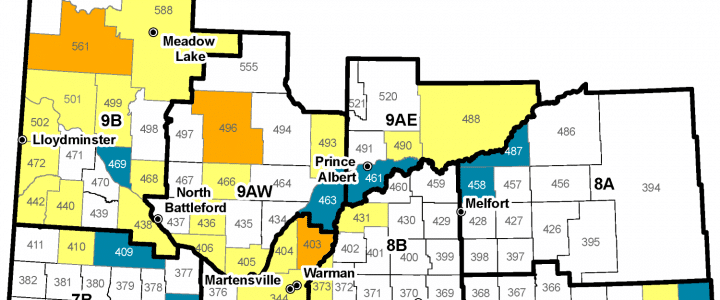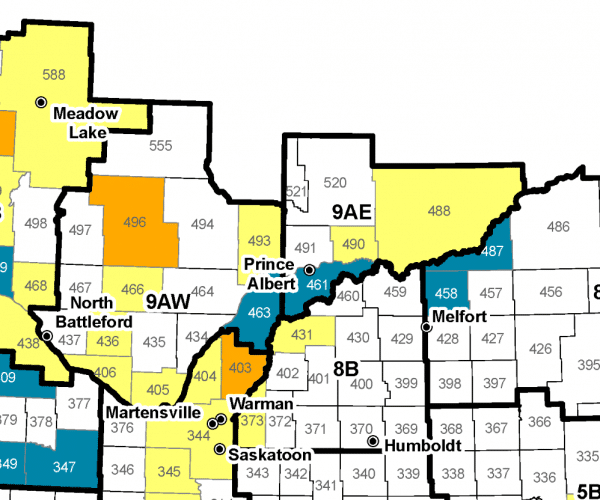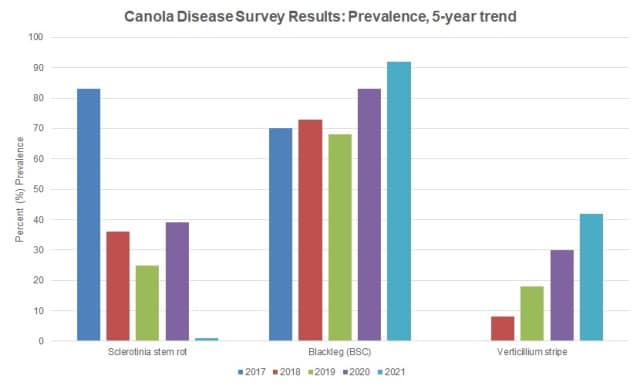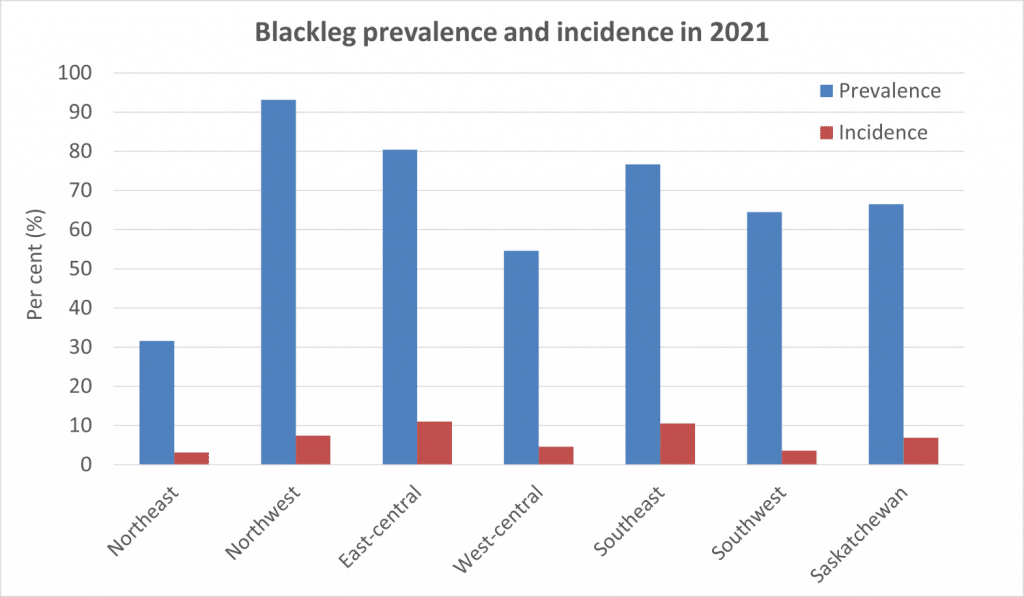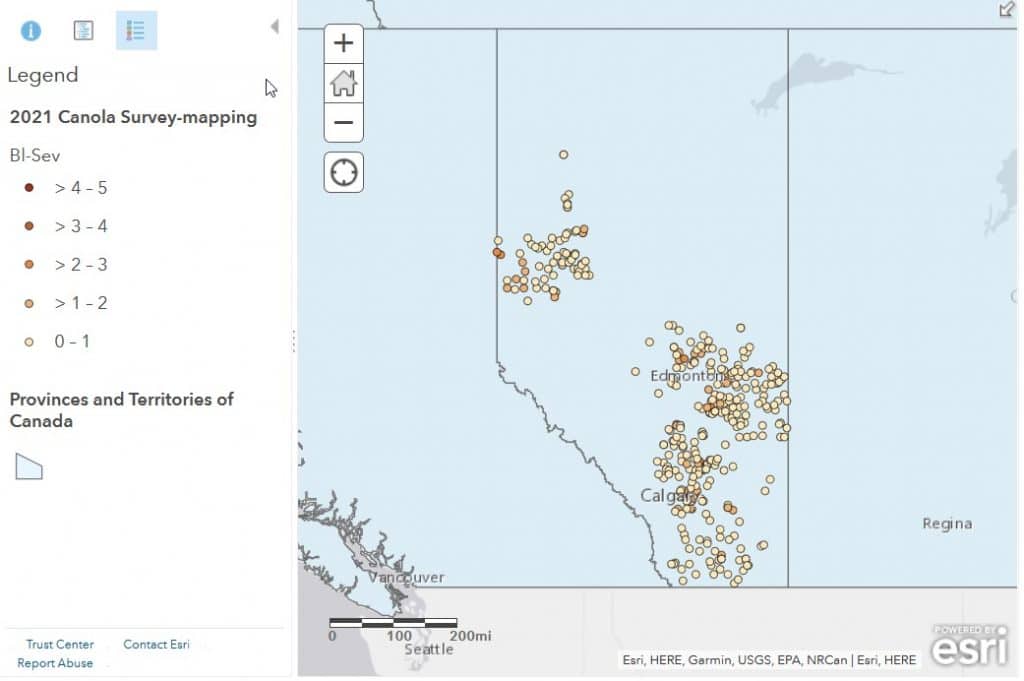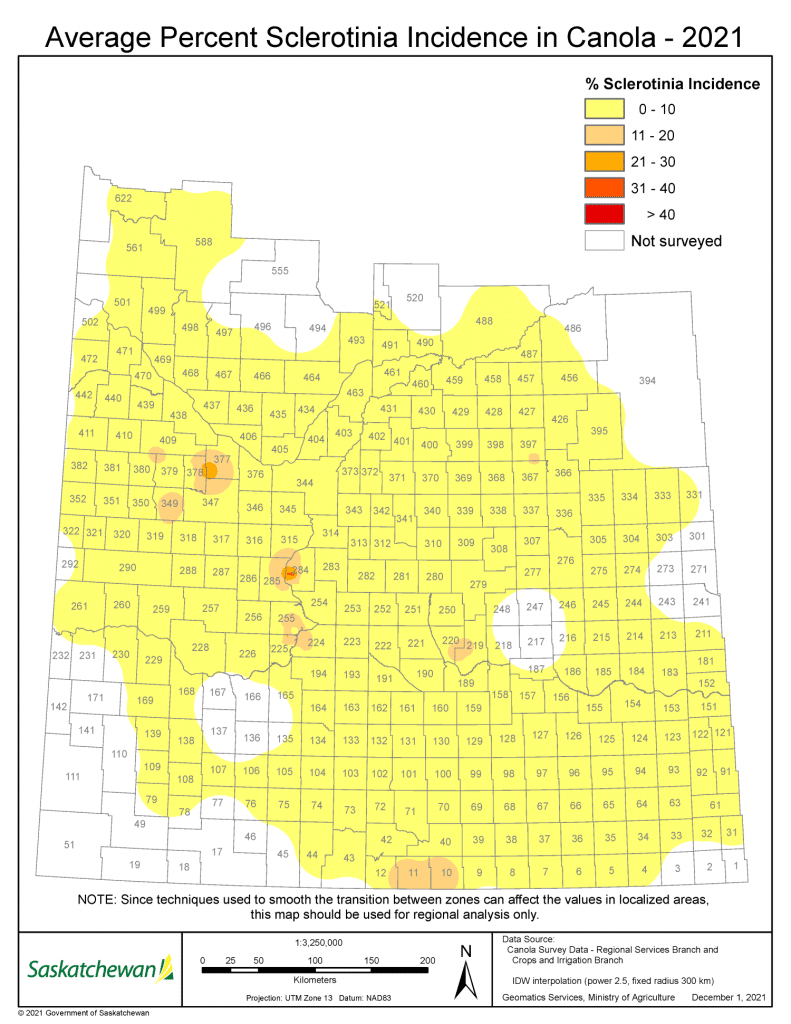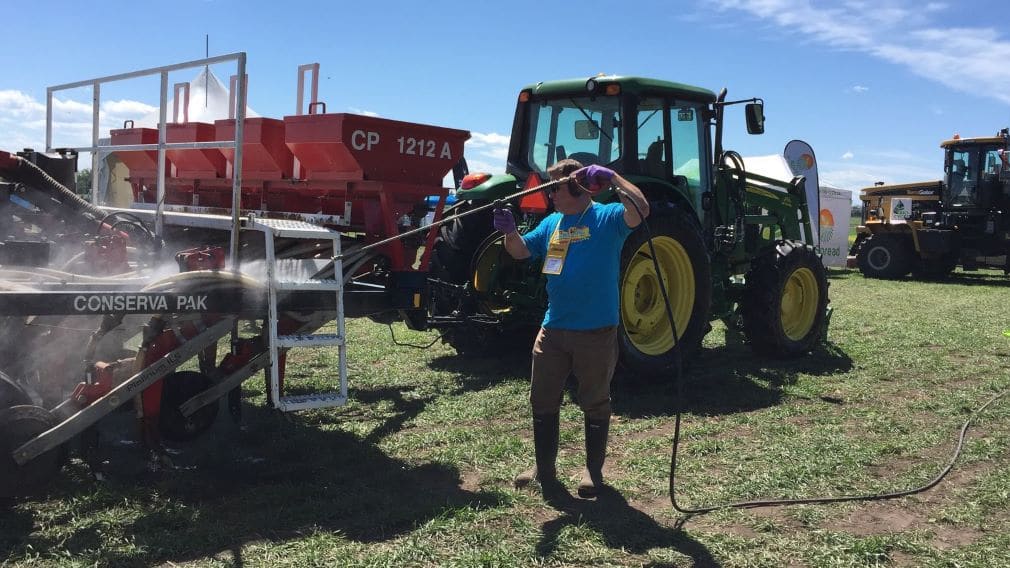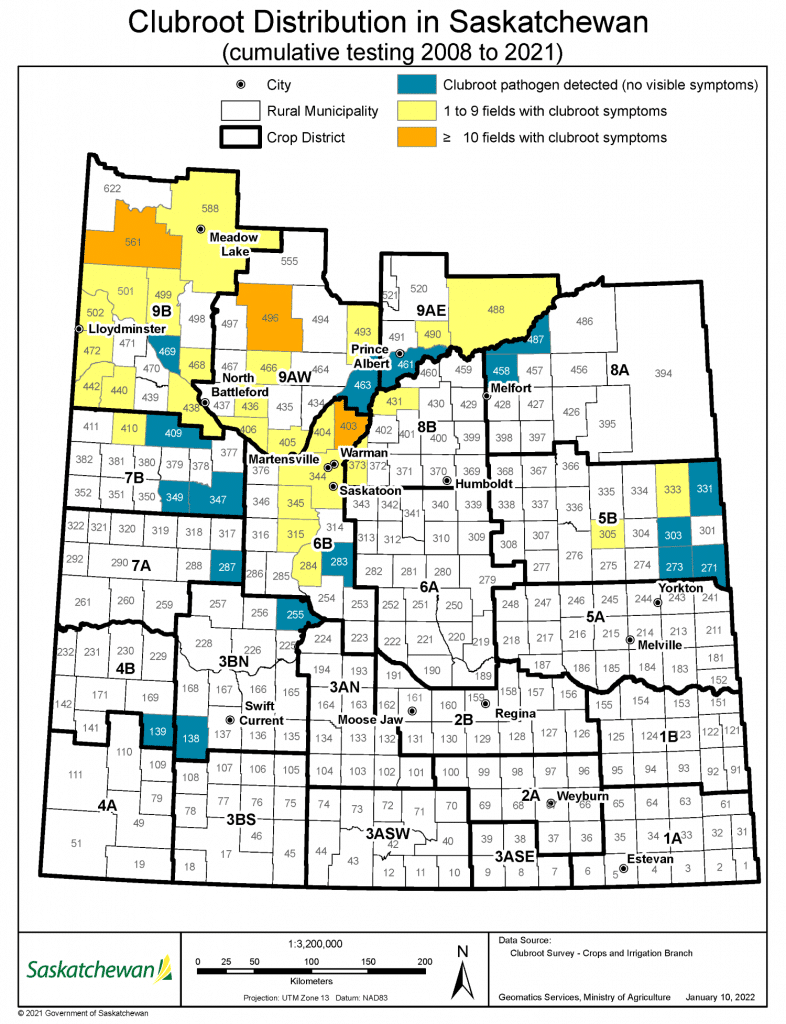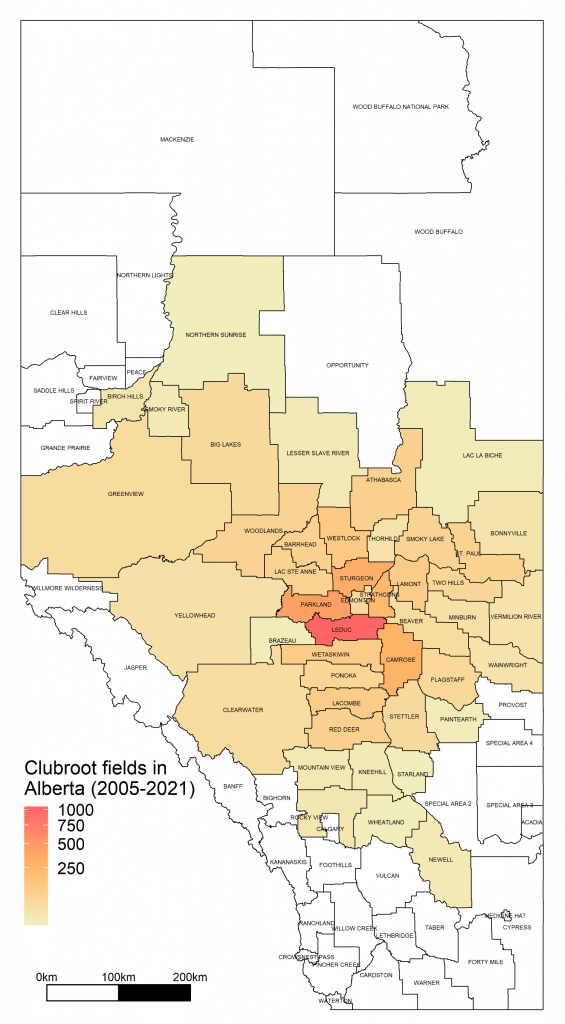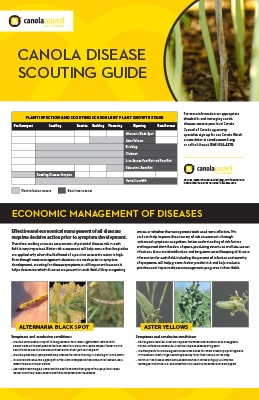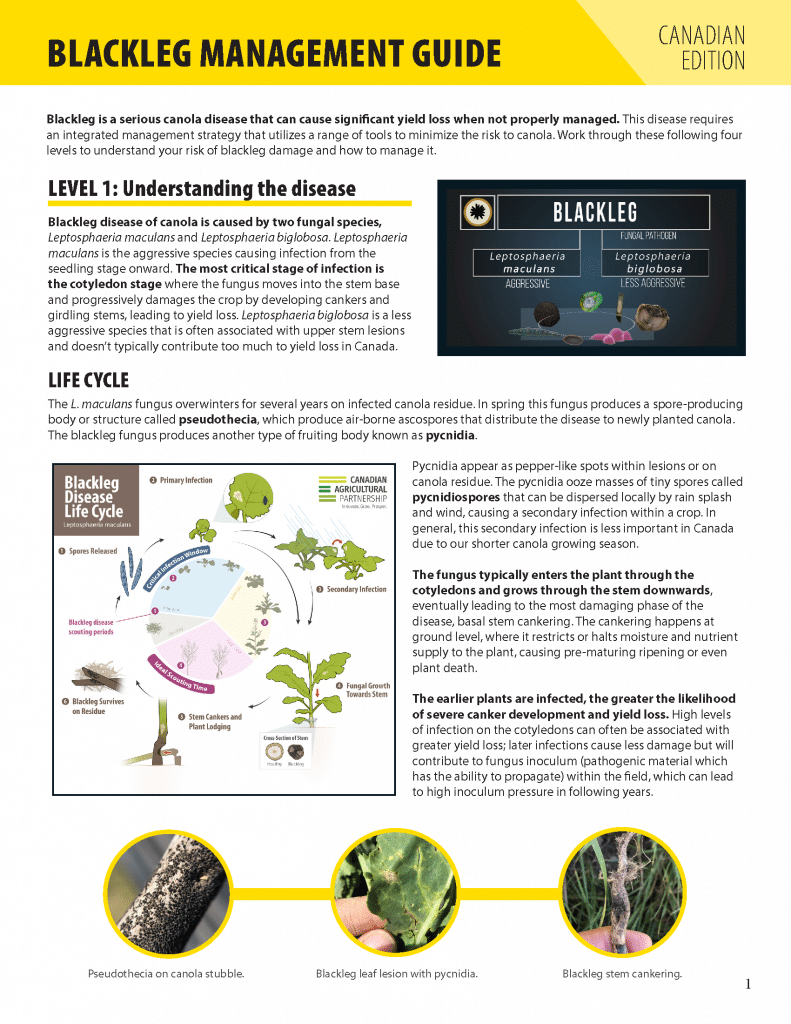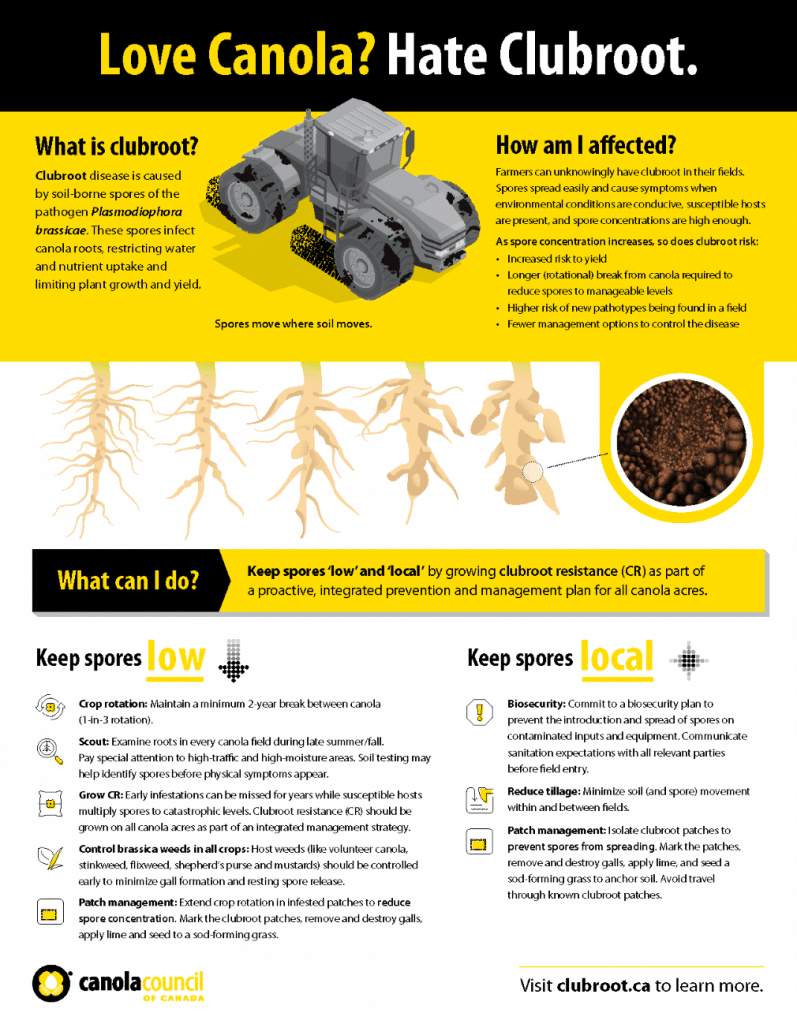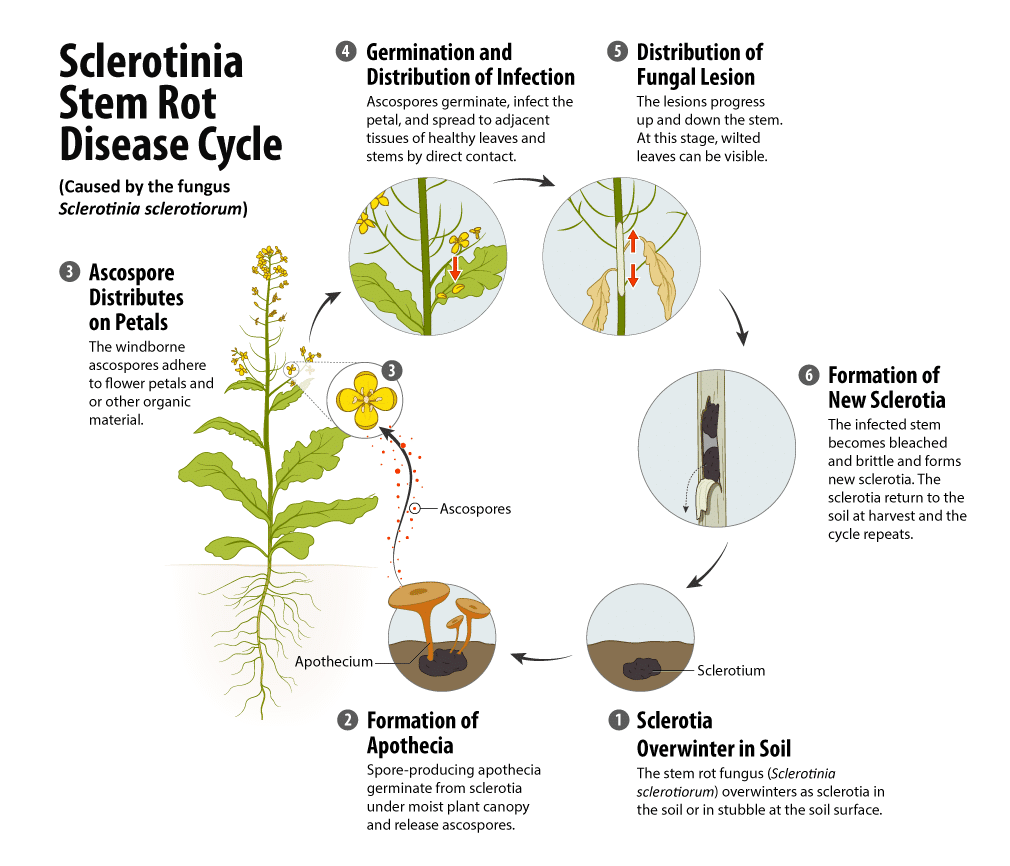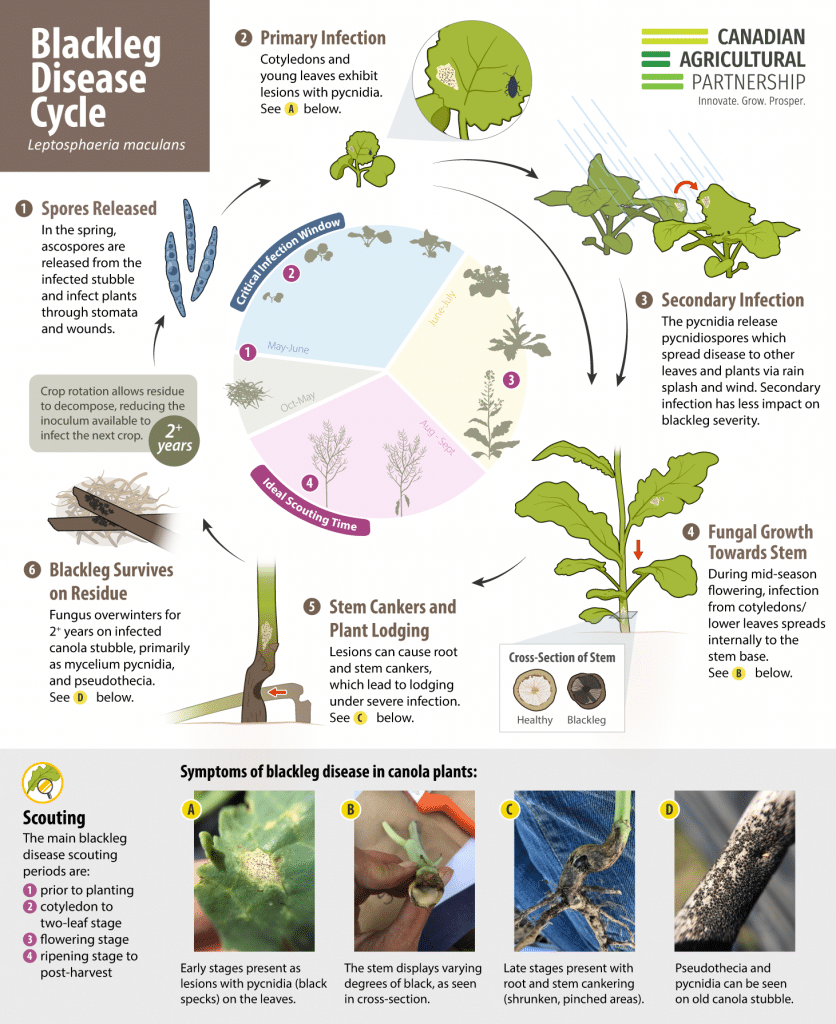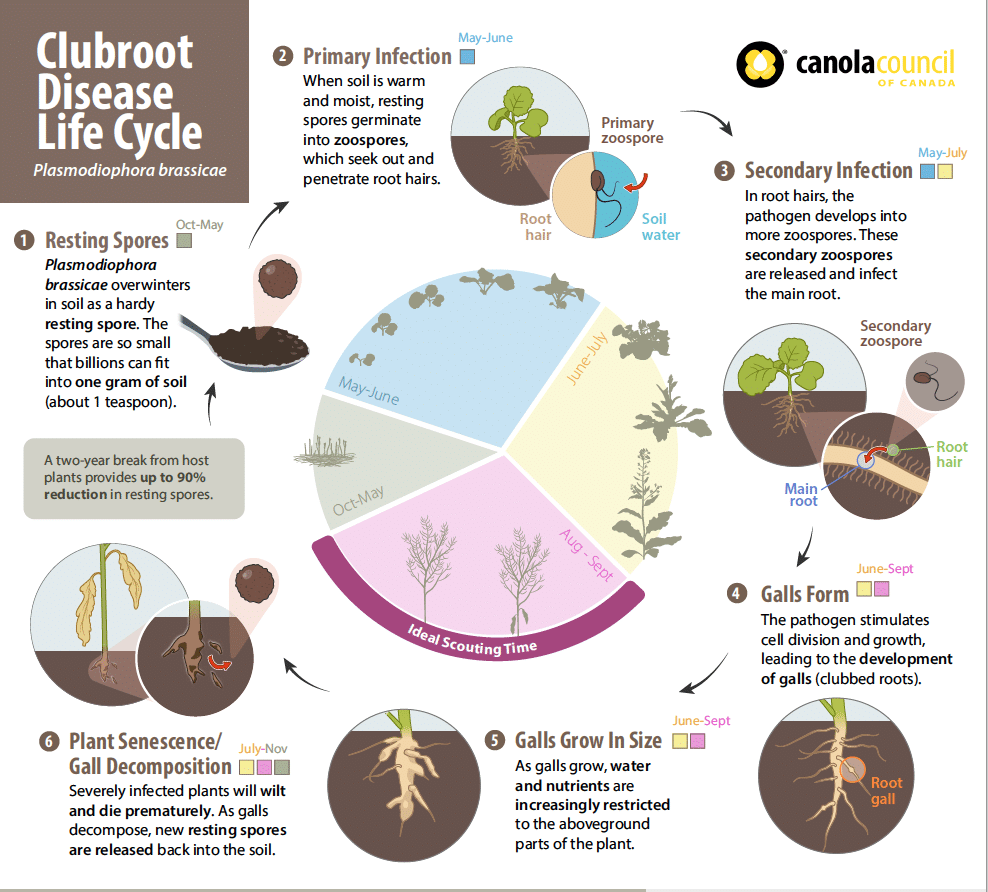Crop disease surveillance is critical every growing season – both at the individual field scouting level and at the regional or provincial surveying level. While the Prairie-wide insect monitoring network equivalent for disease monitoring is still in development, there are many research projects and coordinated provincial efforts that take place annually to summarize the disease situation (occurrence, distribution and severity). This information can be used to assess the previous year’s management strategies and make improvements for the following season. When collected over time, these annual snapshots can also be analyzed for trends and considered for future disease risks (especially in neighbouring provinces, when distribution trends are increasing).
This blog reviews available 2021 survey results of blackleg, clubroot and sclerotinia in canola and related disease surveillance research projects that describe the current situation. By considering disease risks, management options and available resources, canola growers and agronomists can use more effective strategies to manage canola diseases and minimize negative impacts this coming growing season. Growers can contribute by supporting the annual provincial surveys, which collect this crucial data.
An informative pathology recount for the Prairies is available in this 2021 Oilseed Disease Situation Report from the Western Committee on Plant Diseases of the Western Forum on Pest Management. For a comprehensive recap of the disease situation in 2020, check out this annual survey report in the Canadian Journal of Plant Pathology.
Blackleg survey results
While blackleg is a major disease of canola that is being monitored in each province, the focus is more on the prevalence, incidence and severity of the disease.
- Prevalence is the percentage of crops surveyed that have the disease.
- Incidence is the percentage of plant surveyed within each field that have symptoms of the disease.
- Severity is the proportion of plant tissue that shows disease symptoms.
The latest blackleg updates from each of the Prairie provinces are represented below.
The Canola Research Hub contains 35 blackleg-related research projects you can check out including:
Sclerotinia stem rot monitoring
Forecasting for sclerotinia stem rot in canola continues to be a challenge, but research efforts are making progress on this and other sclerotinia decision-making and management and topics. The Improving the management of sclerotinia stem rot of canola using fungicides and better risk assessment tools project, which won’t wrap up until 2023, is an example of this.
This Canadian Agricultural Partnership (CAP)-funded project led by Dr. Kelly Turkington aims to improve management practices for Sclerotinia sclerotiorum developing a better understanding of the relationship between inoculum availability and environmental conditions before and during flowering, and how this impacts stem rot risk and fungicide response.
The researchers are looking at factors (such as seeding rate) that influence crop development, as well as variability in flowering and the resulting fungicide efficacy at different canola growth stages. They will evaluate fungicide efficacy when applied as a single early application or as dual applications at different flowering stages, and will refine the use of qPCR analysis and investigate the use of spore traps to assess inoculum load before and during flowering.
The ‘Development of a biosensor for sclerotinia stem rot disease forecasting in canola’ project is another (CAP)-funded project on this canola disease which aims to develop an in-field real-time sensor to monitor plant disease pathogens, specifically the sclerotinia stem rot pathogens. The team plans to achieve this by completing these objectives:
- Complete the transition of spore detection technology/device from a large instrument to a portable chip that can be easily applied to field application by antibody coating and signal enhancement.
- Establish the correlation between disease severity and spore number under controlled and field environments.
- Field verification of the technology for future deployment.
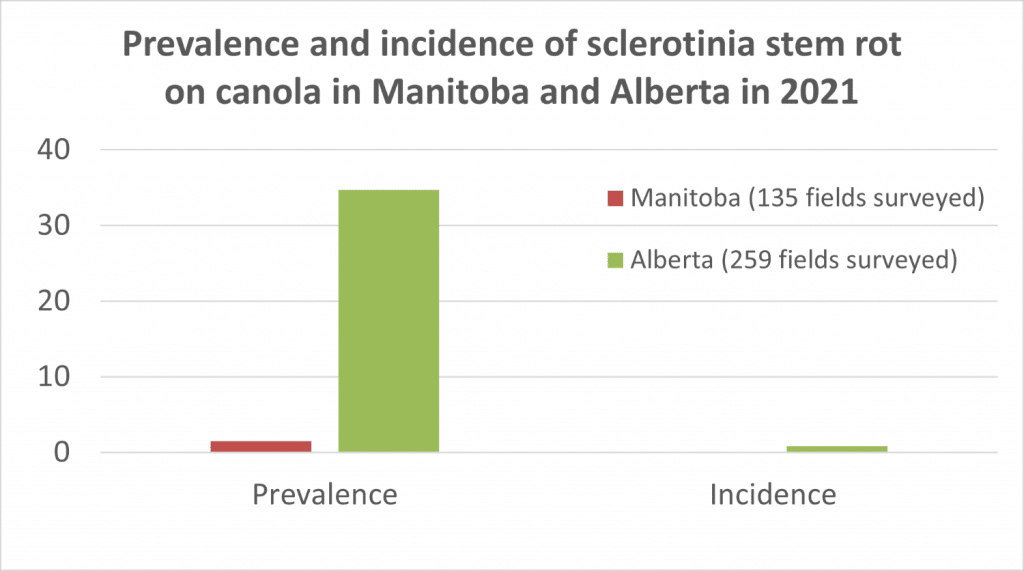
For more information, check out the other 29 sclerotinia research projects on the Canola Research Hub, including:
- 25 completed projects &
- 4 ongoing projects (in addition to the two previously mentioned projects)
The dry conditions in 2021 likely impacted the sclerotinia survey outcomes, including the Saskatchewan sclerotinia map pictured.
Clubroot surveillance progress
The ‘Clubroot surveillance and epidemiology: staying ahead of an important canola issue‘ project monitored clubroot infestations to see how prevalent it is in particular regions of Alberta, and how quickly clubroot is spreading. In addition, the research tracked the predominant pathotypes or strains of P. brassicae on the Prairies, and looked at whether genetic resistance was holding up in the field. Key outcomes from this project were:
- A survey of 554 canola crops in central and southern Alberta resulted in the identification of 72 new cases of clubroot – including the first records of it in 4 counties (Big Lakes, Brazeau, Lac La Biche County, Paintearth) and the Municipal District of Wainwright. In addition to this, 229 more records were confirmed in field inspections carried out by municipal and county personnel in 2017.
- While most severely infested crops were confirmed to be susceptible canola hybrids, significant symptoms of clubroot were identified in at least 45 fields planted to resistant canola cultivars.
- One of the 42 soil samples collected in Manitoba in 2017 tested positive for the presence of P. brassicae.
- The four Saskatchewan canola root samples infected with P. brassicae were not found to have pathotypes capable of overcoming resistance.

Concerned about the spread of novel clubroot strains, the 3-year ‘Characterization of new strains of the clubroot pathogen in Alberta‘ project surveyed commercial canola crops in 40 Alberta counties and municipalities between 2014 to 2017. The research team found:
- Surveys identified 17 known pathotypes in Canada, including at least 11 of which can break resistance in CR canola (and five of which are the original “old” ones).
- Further examination and naming of the virulence patterns of each P. brassicae population resulted in the development of the Canadian Clubroot Differential (CCD) Set.
- It represents an improved system for the identification of new virulence profiles of Plasmodiophora brassicae and their classification into pathotypes. It also helps to quickly determine pathotypes’ ability to overcome resistance.
- The CCD is an important new tool that can be applied directly on the ground by the sector, including agronomists and researchers. The CCD can also be used by breeders for screening purposes, to assist with the identification of effective resistance sources and the development of new CR canola products.
The ‘Development of a harmonized clubroot map’ project attempted to develop a Prairie-wide map. While the project did meet its objectives of examining the feasibility of a harmonized Prairie clubroot map, determining what such a map could look like, and communicating findings and recommendations to stakeholders including the Clubroot Steering Committee. It didn’t result in a three-province harmonized map.
The project lead, Dr. Stephen Strelkov wrote: “Despite the potential benefits of harmonized clubroot maps, the sensitivity related to this disease and its distribution may make their adoption difficult in the near future. This was highlighted in the current study by the difficulty in obtaining data from some provinces. Nonetheless, all provinces should be encouraged to continue record keeping and gathering data for the eventual execution of this map.”
Provincial clubroot maps
The provinces each put out maps (nearly every year) of the clubroot situation. Here are the latest versions from each of the resulting maps:
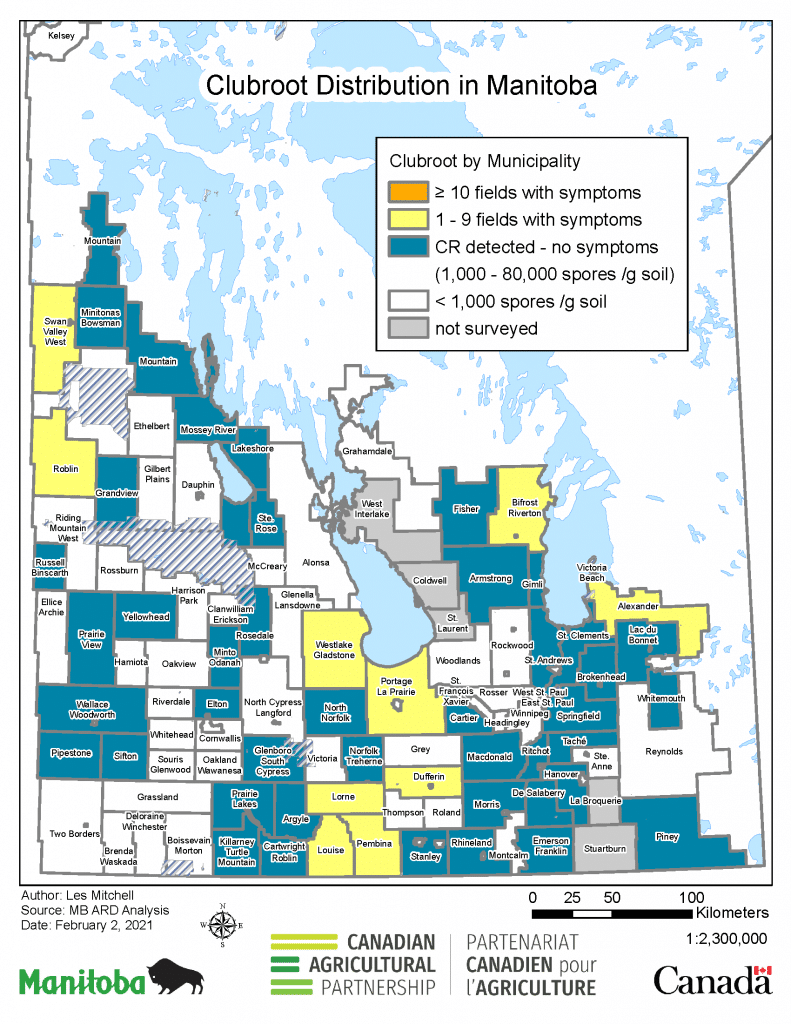
To learn about some other interesting ongoing clubroot research, check out these newly-added projects:
- Canadian Canola Clubroot Cluster Pillar 1: Integrated disease management
- Canadian Canola Clubroot Cluster Pillar 2: Developing novel resistance resources and strategies to address the new threat of clubroot canola production on the Prairies
- Canadian Canola Clubroot Cluster Pillar 3: Host-pathogen biology and interaction
Or check out the other 27 clubroot research projects featured on the Canola Research Hub.
Scouting and management resources
In addition to showing support for ongoing disease monitoring efforts by providing access to the annual provincial disease surveys, scout your own fields, or your grower’s fields, with the helpful canola disease scouting guide, and use these blackleg and clubroot guides to help you manage these canola diseases.
Published March 31, 2022


